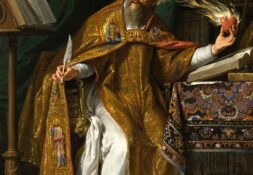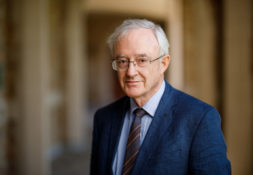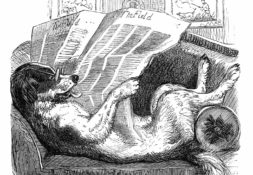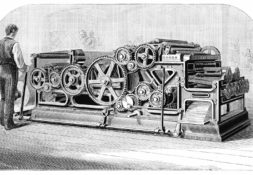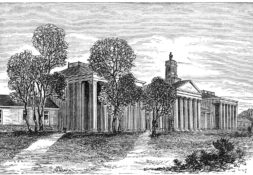What led sociology professor Christian Smith and his wife Emily to embrace the Catholic Church and convert from Protestantism this past April? The richness, tradition, and authority of the Church, and, ultimately, the rational sense-making to weather the assaults of modernity!
Christian Smith is the William R. Kenan, Jr. Professor of Sociology here at Notre Dame and the Director of the Centers for the Study of Religion and Society and for Social Research. His research focuses on religion in modernity, adolescents, American evangelicalism, and culture. Chris has a BA from Gordon College, and an MA and PhD from Harvard University. He was Professor of Sociology at the University of North Carolina at Chapel Hill for 12 years before joining Notre Dame in 2006 as a Kenan Professor.
Chris is a prolific author and scholar. By my count, he has published 12 books in some of the most distinguished academic presses: Oxford, Berkeley: U California, U Chicago, and Routledge. His most recent book, co-authored with Patricia Snell, Souls in Transition: The Religious and Spiritual Lives of Emerging Adults, received Christianity Today’s 2010 Distinguished Book Award. He won the same award for his 2005 book, co-authored with Melinda Lundquist Denton, for Soul Searching: The Religious and Spiritual Lives of American Teenagers. He has won numerous other awards, many of them detailed on his Wikipedia page: “Christian Smith (sociologist).”
As a convert myself, I was intrigued by Chris’s story when I first met him a few months ago as he celebrated the Christian rites of initiation into the Catholic Church. I will try to convey the story of his conversion and some of the key issues that drew him to consider the case for Catholicism. In some ways, his story is similar to what he writes about: namely, the religious and spiritual lives of young adults (or spiritually young adults!), whom he describes as “souls in transition.”
Chris grew up in a conservative Presbyterian family in the Reformed evangelical tradition, moving from that to, in his words, “low-church Anabaptism and eventually Anglicanism.” When I questioned Chris about the role Scripture has played in his life, he remarked that “Scripture was (supposedly) the only thing that mattered in Protestantism” and that he had studied Scripture a lot over the years. Chris made the astute remark that scripture can be interpreted in many (countless?) ways and “that’s why the world is full of literally thousands of Protestant denominations – utter fragmentation and chaos.”
At this point is his life, Chris wants to learn more of what the Church has to say about Scripture rightly interpreted than to study it on his own. Chris went on to say that the interpretation of Scripture is inescapable and yet Scripture itself is highly “multi-vocal.” So how do we interpret it rightly? The only way is with ecclesial authority as the glue that binds the people of God together. So, Chris’s starting point for his entry into Catholicism was a search for, in his words, “ecclesial unity, genuine catholicity, connection to historical tradition, historical and authoritative sense-making of scripture, and the ability to find a rationally-warranted place to stand that will not be blown away by the forces of modernity.” How’s that for a collection of reasons to search out and find the Barque of Peter?
So how did Chris make it from Presbyterianism all the way to Catholicism? Chris’ first book in 1991 from his dissertation work, The Emergence of Liberation Theology, forced Chris to examine the corpus of Catholic Social Teaching in depth. According to Chris, “The tradition of Catholic Social Teachings is really impressive, powerful, and often under-appreciated. As life went by, I increasingly realized what I have come to see as the flaws and impossibilities of Protestantism, both its liberal and evangelical versions.” One of those impossibilities, alluded to above, is the notion that private interpretation of Scripture can lead to anything other than utter fragmentation and thousands of sects. Indeed, for the Church to be united around Christ, there has to be some form of earthly authority that prevents that fragmenting. Other “flaws and impossibilities” include sola scriptura itself as a doctrine, the rejection of a strongly sacramental view of the material and bodily world, and the cutting of self off from most historical tradition and communion of believers at a global level.
Chris says that becoming Catholic was a gradual 13 year process that involved “a lot of reading, talking, thinking, inquiring, arguing, reconsidering, and prayer.” Chris had learned in his previous faith traditions “a number of visceral and intellectual reactions against Catholicism, most of which are misguided and groundless, but they are real and so still need to be addressed.” Some of those reactions and stumbling blocks include Mariology, praying to saints, papal infallibility, and other standard Protestant objections to Catholicism. According to Chris, the more carefully he looked at this issues in detail, “the more I discovered that the view I had been taught as a Protestant to think that Catholics believed was either flat wrong or badly distorted. I learned that these Catholic teachings can make good sense when accurately and properly understood.”
One of Chris’ most fascinating comments to me about his conversion was his point that for many “Protestants to really start ‘getting’ Catholicism requires not only a lot of focused learning of facts, but also a kind of basic ‘paradigm shift’ into a quite different way of understanding life, the world, and faith. Protestantism forms a mindset that tends to be linear, literal, either/or, univocal, didactic, and rationalist. Catholicism is more analogical, both/and, metaphorical, curvilinear, symbolic, and multi-directional.” In a word, richer.
I have heard Scripture scholars characterize the difference as viewing faith and religion legalistically instead of through the lens of a family. The Church is a family, with God as Father, Jesus as Brother, Mary as Mother, and the Saints as our older brothers and sisters. Scripture also is to be interpreted using the “senses” of Scripture, which include the literal, analogical, moral, and eschatological senses. It was the wise, well-informed, and faithful Catholics along the way who helped in this discernment. Near the end of that process, many of those faculty, administrators, and priests were here at Notre Dame. Chris cites the support and instruction of “great people like Fathers Richard Warner, Lou Delfra, Tim Scully, Peter Rocca, Mark Poorman, and others” as “immensely helpful and appreciated.” Notre Dame also offers great liturgy. Chris says the 11:45 am Folk Mass on Sunday in the Basilica is one of his favorites. Chris also appreciates Notre Dame colleagues (both Catholic and not) to talk to and the many “models of faithful Catholic living and thinking,” which, he points out, are “not to be found everywhere.”
Chris understands the fact that Notre Dame is different for different people. The Catholic Church and the Catholic way of being in America is an enormously broad spectrum. As Chris says, “Notre Dame is a lot what anyone makes of it.” But as he has discovered, “There are wonderful personal, institutional, and cultural commitments to and resources for faithful Catholic living here.” I too have found this to be the case. Where else in the American academy can one find so many chapels, places of prayer, and abundant sacramental life there for the taking? Where else can one find so many examples of faithful Catholic living and thinking among your colleagues and students? The Church is not about imposing, but rather proposing, and Christian and Emily Smith accepted that proposal and said “yes” seven months ago.
Chris wanted to ensure that I extended an invitation to all Irish Rover readers to sign up for his courses in sociology.
Peter Kilpatrick is Dean and professor of the College of Engineering. He can be contacted at pkilpat1@nd.edu.
